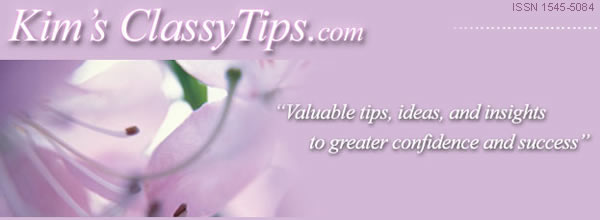

![]() Welcome to my ClassyTip for this week which focuses on:
Welcome to my ClassyTip for this week which focuses on:
- Appearance
- Behavior
- Communication
- "To Your Health" Making a Toast - Tip #20
Do you want to add a special touch to an occasion your hosting? You may want to acknowledge the reason for the event and give special recognition to one of the guests. Offering a “toast” will provide you with both opportunities, as it’s a gracious way to welcome guests, to recognize someone’s accomplishments, and to honor a person on their special day. It’s a gesture that adds a special touch to any occasion, even a casual get together.
This tradition of “toasting” dates back centuries. The Greeks and Romans toasted their pagan gods, and early Norsemen toasted each other for success before going into battle. The first recorded toast occurred when King Vortigen of England hosted a feast for his Saxon allies in 450 AD. It was a toast to good health and fortune, and today people toast to good health, good fortune, good luck, success and happiness.
A toast is a moment within the celebration that focuses everyone’s attention. And since the process includes everyone, I’ll go over the details for you.
-
Host
If
you’re the host or hostess for the event, you’ll have
the responsibility to make the welcoming toast, if there is one, and
the first toast recognizing the guest of honor. At a formal event, you
will stand and pause to get everyone’s attention. Then looking
at the guests, or the guest of honor, you’ll have your wine or
champagne glass in hand and propose the toast. When you’ve finished
the toast, you’ll raise your glass, still looking at the guests,
or guest of honor, and then take a sip from your glass. The process
should be short, but dignified.
At certain formal occasions, such as State or military dinners and wedding receptions, the toasts are part of the protocol for that event. This protocol will identify who makes what toasts and when they are made. This structure is critical for orchestrating the correct order that must be followed.
- Guest of Honor
If you’re the guest of honor at the event, you’ll always
remain seated as you’re being recognized by a toast. And you’ll
not pick up your glass of wine or drink any wine when the toast is made.
You will however, keep your eyes on the person who is toasting you, and graciously accept the toast using your eyes and facial expression.
When the host’s toast honoring you is finished; you, in turn, will offer your own toast back to the host/hostess. You may remain seated, look at the host, lift your wineglass, and say “thank you”. Or you may say a few more words to your host, but the essence of the toast is to thank the host for the celebration.
- Other Guests
At a formal affair, all the guests except the guest of honor will stand
for toasting the guest of honor. At a less formal event, the host may
stand to offer the toast, but the other guests will remain seated.
When a toast is being proposed, look at the person being toasted, and remain looking at that person during the toast. You’ll have your wine or champagne glass in your hand, and when the toast is completed and the host raises his glass, you’ll also raise your glass. Then you’ll take a sip from your wineglass.
- Types of Toasts
Traditionally there are two types of toasts that will occur at most functions – the
welcoming toast and toasts recognizing the guest or guests of honor.
At formal affairs, the host and the guests will stand. At informal or
casual affairs and in many restaurant settings, the host may chose to
stand but all the guests will remain seated. And at a small event, the
host may even remain seated when proposing a toast.
At an informal event, spontaneous toasts may be offered by any of the guests.
A toast should be short and always in a positive, uplifting tone. Humor can certainly be used, as long as it’s appropriate. However, if you’re not comfortable using humor, it isn’t critical to the success of a good toast.
Welcoming toast–
- This toast will occur at the beginning of the event or the meal.
- The host will stand if it’s a formal occasion or there’s a large group.
- The host may select champagne for the welcoming toast, or may use wine.
- The host will toast all guests, welcoming them to the occasion, by holding the glass, proposing the toast, raising his glass, then sipping the champagne or wine.
- The guests will all raise their glasses, when the host raises his, and then sip their champagne or wine.
Toasting the guest of honor -
This toast is the gracious gesture that honors or recognizes
a special person in attendance.
- The host is the first person to offer this toast (if there will be more than one toast honoring the guest of honor)
- The toast occurs after the entrée is finished and before desert.
- At a formal dinner the host will stand, holding a glass of wine, and face the guest of honor.
- On that signal all others, except the guest of honor, will also stand, holding a glass of wine, and face the honored guest.
- The host will offer the toast, which should be short. (Humorous is nice, but not mandatory.)
- At the end of the toast, the host and everyone standing will raise their wineglass and then takes a sip.
It’s not necessary to "clink glasses" before sipping the wine. But should you find yourself at a table where this is occurring, politely participate.
The guest of honor
During this entire toasting process, you, as the guest of honor, will
remain seated, and graciously accept the toast by looking charming
or gorgeous, whichever the case may be. You don’t participate
in holding a glass of wine or drinking from your wineglass.
- Once the host’s toast is complete and all the other guests have taken their sip of wine, you as the honored guest will now stand, or you may remain seated, take your wineglass and toast the host, thanking him for hosting the occasion.
- The toast should be short. A simple, "thank you" is very acceptable.
Other guests
- If you’re a guest who wants to also recognize the guest of honor or the host by proposing a toast, you will wait until after the host has made the first toast to the guest of honor.
- If the event does not have a formal protocol, you may rise and offer your toast
- If it appears that the host isn’t going to propose a toast to the guest of honor, you may discreetly ask if the host would mind if you proposed a toast. This request may remind the host, and he will propose the first one; or he may tell you to go ahead and be the first.
Toast
at an informal event –
There are two key differences for a toast at an
informal event.
- Anyone may be the first to offer a toast.
- Everyone will remain seated for the toasts.
A
simple toast – "To
your health"
This is always a brief and appropriate toast, and can be used at even
the most casual gathering. If you travel to other countries or host
people from other nationalities than your own, learning the correct
translation and pronunciation for this will be a nice toast to use
for any occasion.
The following are several translations for this phrase.
- French – A votre Sante
- German – Prosit
- Italian – Salute
- Irish – Slainte
- Russian – Na zdorov’e
- Spanish - Salud
- Swedish – Skoal
- Yiddish – L’Chayim
- Consuming Alcohol
No matter what you may have seen in the movies, it’s not necessary
to drink the full glass of wine or champagne for every toast. A small
sip is fine. This is especially helpful if the occasion will have a number
of toasts.
You may be visiting a country with a tradition of multiple toasts. An example is in the Far East, where toasts will occur continuously throughout the evening.
In China, the host will offer the first toast, and then others will continue toasting during a banquet. And in Korea it’s considered impolite to drink alone. So another person at the table will make eye contact with you as a sign to "have a drink together". Then a short time later another person will make a verbal toast, including you in the process, for the next sip or drink of wine or alcohol. And so this continues throughout the evening.
If you’re attending an event where there’s continual toasting, and you’re not a heavy drinker, cautiously take a very small sip of wine for each toast, since you won’t know how many toasts will take place. This way you’re able to remain comfortable and in control during the evening.
- Non-alcoholic beverage
If you choose not to drink alcohol, ask for a non-alcoholic beverage
and use that for the toasts. If a toast is being made and you don’t
have a non-alcoholic beverage available, politely raise your wineglass.
Some etiquette books recommend "pretending to sip" by holding the glass next to your lips. If you’re comfortable doing this, you certainly can. But for some, even the aroma and fumes of alcohol can be a problem. In this case, use either your water glass or even an empty glass, when you raise a glass during the toast.
- A side note: Throughout the world, your health is always a good excuse not to drink alcohol. You don’t need to elaborate, just ask the waiter for something non-alcoholic to drink. If you feel you awkward and want to say something to a dinner partner, a simple “I’m in training right now” or “The doctor said I need to avoid it for now” is all that’s necessary.
- Conclusion
If an event is scheduled, and the classy person knows he or she will
be proposing a toast, that toast is rehearsed so it’s smoothly
delivered with a sincere and confident tone of voice.
The classy person understands that an appropriate toast can add a special touch to an occasion. He or she will develop the skill and plan for the opportunity; so when the occasion arises, a simple but eloquent toast will be.
I'm Looking forward to sending you another of my ClassyTips next week. Until then, have a great week, and don't forget to visit my Forum that answers your questions on 'Becoming the Best You Can Be'.

Do you have a friend or associate you think may like to receive my free, weekly ClassyTips Newsletter? If so, just press here to let them know.
Also, remember you can always send your questions, thoughts, ideas, and suggestions directly to me at Kim's ClassyTips
This message is sent in compliance with California Business and Professions Code, Section 17538.4. This mail is never sent unsolicited, and is only delivered to users who have provided their email address in agreement to receive these emails. If any user wishes to be removed from this subscription list, they may freely and at any time use the unsubscribe link or simply reply to this email with "Remove" in the subject line.
For help, please email support@ClassyTips.com
© 2003 ClassyTips.com - all rights reserved
secure-mailer.net
is powered by
AutoResponse
Plus